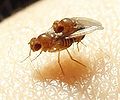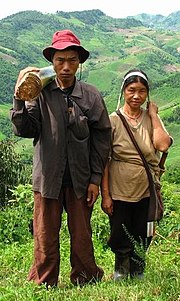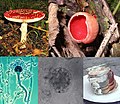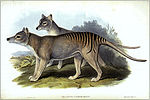In biology, coevolution occurs when two or more species reciprocally affect each other's evolution through the process of natural selection. The term...
49 KB (5,377 words) - 07:32, 29 October 2024
Host–parasite coevolution is a special case of coevolution, where a host and a parasite continually adapt to each other. This can create an evolutionary...
26 KB (3,038 words) - 23:54, 11 April 2024
figs, and tied wild fig fruits on to the cultivated trees. Overall, the coevolution of Ficus and wasps features Ficus being very specific as a host, combined...
10 KB (1,262 words) - 21:04, 14 July 2024
Mosaic coevolution is a theory in which geographic location and community ecology shape differing coevolution between strongly interacting species in multiple...
6 KB (869 words) - 23:47, 17 October 2024
Escape and radiate coevolution is a hypothesis proposing that a coevolutionary 'arms-race' between primary producers and their consumers contributes to...
14 KB (1,853 words) - 08:55, 16 December 2023
Bee (redirect from Coevolution of bees and flowers)
pollination, and are the most efficient pollinating insects. In a process of coevolution, flowers developed floral rewards such as nectar and longer tubes, and...
119 KB (12,339 words) - 14:29, 29 October 2024
CoEvolution Quarterly (1974–1985) was a journal descended from Stewart Brand's Whole Earth Catalog. Brand founded the CoEvolution Quarterly in 1974 using...
3 KB (220 words) - 19:17, 1 March 2024
Cooperative Coevolution (CC) in the field of biological evolution is an evolutionary computation method. It divides a large problem into subcomponents...
4 KB (368 words) - 23:37, 15 November 2021
female reproductive tracts may also play a role in sexual antagonistic coevolution with males. In Drosophila species, a large group of enzymes known as...
15 KB (2,055 words) - 07:03, 14 June 2024
Dual inheritance theory (redirect from Gene-culture coevolution)
Dual inheritance theory (DIT), also known as gene–culture coevolution or biocultural evolution, was developed in the 1960s through early 1980s to explain...
68 KB (8,229 words) - 03:11, 12 August 2024
Polymorphism Genetic drift Gene flow Speciation Adaptive radiation Co-operation Coevolution Coextinction Contingency Divergence Convergence Parallel evolution Extinction...
69 KB (6,803 words) - 00:22, 21 October 2024
Sexual conflict (redirect from Sexually antagonistic coevolution)
Sexual conflict or sexual antagonism occurs when the two sexes have conflicting optimal fitness strategies concerning reproduction, particularly over the...
67 KB (8,685 words) - 21:33, 27 August 2024
103H. doi:10.1038/ncomms1105. PMID 21045821. Brundrett, M. C. (2002). "Coevolution of roots and mycorrhizas of land plants". New Phytologist. 154 (2): 275–304...
139 KB (17,332 words) - 20:35, 1 November 2024
means. Venom is used as a trophic weapon by many predator species. The coevolution between predators and prey is the driving force of venom resistance,...
40 KB (4,280 words) - 12:27, 3 November 2024
Retrieved 12 October 2020. Lunau, Klaus (2004). "Adaptive radiation and coevolution — pollination biology case studies". Organisms Diversity & Evolution...
95 KB (8,058 words) - 07:51, 19 October 2024
2005). "Coevolution and Pollination". University of Cincinnati. Archived from the original on 30 April 2009. Retrieved 9 May 2009. "Coevolution and Pollination"...
134 KB (12,788 words) - 00:37, 7 October 2024
Ecology (section Coevolution)
Ecology (from Ancient Greek οἶκος (oîkos) 'house' and -λογία (-logía) 'study of') is the natural science of the relationships among living organisms, including...
210 KB (21,521 words) - 11:27, 21 October 2024
Pollinator Partnership (redirect from Coevolution Institute)
important pollinating species. The Pollinator Partnership was founded as the Coevolution Institute (CoE) in 1997. The early mission of the organization was to...
4 KB (399 words) - 12:39, 17 October 2024
Evolutionary biology (section Coevolution)
procedures. The influence of two closely associated species is known as coevolution. When two or more species evolve in company with each other, one species...
31 KB (3,423 words) - 11:50, 11 September 2024
these toxins for their own survival. This "arms race" has led to the coevolution of insects and their host plants. No form of wing is externally visible...
155 KB (16,853 words) - 17:39, 30 October 2024
through genetic changes and they feed on the amphibians with impunity. Coevolution occurs with the newt increasing its toxic capabilities at the same rate...
161 KB (18,019 words) - 19:28, 2 October 2024
Sun L, Yu YN, Velicer GJ (September 2019). "Bacterial predator-prey coevolution accelerates genome evolution and selects on virulence-associated prey...
106 KB (11,117 words) - 00:59, 4 November 2024
strength over other optimisation algorithms, specifically cooperative coevolution, is that it is better able to handle non-separable optimisation problems...
10 KB (1,139 words) - 09:39, 6 February 2022
Predation (redirect from Coevolution of predators and prey)
have been characterized as an evolutionary arms race, an example of the coevolution of two species. In a gene centered view of evolution, the genes of predator...
109 KB (11,580 words) - 20:03, 1 November 2024
Bradley DG, Jann OC, Bertorelle G, et al. (December 2003). "Gene-culture coevolution between cattle milk protein genes and human lactase genes". Nature Genetics...
267 KB (25,501 words) - 22:52, 3 November 2024
ISSN 2041-1723. PMC 7843733. PMID 33510166. Brundrett MC (2002). "Coevolution of roots and mycorrhizas of land plants". New Phytologist. 154 (2): 275–304...
200 KB (19,205 words) - 04:22, 24 October 2024
Polymorphism Genetic drift Gene flow Speciation Adaptive radiation Co-operation Coevolution Coextinction Contingency Divergence Convergence Parallel evolution Extinction...
105 KB (11,165 words) - 02:41, 30 October 2024
Parasitism (section Coevolution)
increased virulence. There are thus varied possibilities in host–parasite coevolution. Evolutionary epidemiology analyses how parasites spread and evolve,...
122 KB (12,317 words) - 10:39, 13 October 2024
Fig wasp (section Coevolution)
Fig wasps are wasps of the superfamily Chalcidoidea which spend their larval stage inside figs. Some are pollinators but others simply feed off the plant...
20 KB (1,974 words) - 02:16, 30 October 2024
between predator and prey, resulting in various antagonistic/competitive coevolutions. Almost all multicellular predators are animals. Some consumers use multiple...
128 KB (11,452 words) - 07:21, 26 October 2024





















